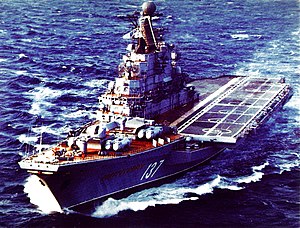Kiev class aircraft carrier

Novorossiysk in 1986
|
|
| Class overview | |
|---|---|
| Builders: | Chernomorsky Shipyard 444 |
| Operators: | |
| Preceded by: | Moskva class |
| Succeeded by: |
|
| Subclasses: | Baku class |
| In service: |
|
| Completed: | 4 |
| Active: | 1 |
| Preserved: | 2 |
| General characteristics | |
| Type: | Aviation cruiser |
| Displacement: | 42,000–45,000 metric tons full load |
| Length: | 273 m (896 ft) |
| Beam: | |
| Draught: | 10 m (33 ft) |
| Propulsion: | 8 turbopressurized boilers, 4 steam turbines (200,000 shp (150,000 kW)), four shafts |
| Speed: | 32 knots (59 km/h; 37 mph) |
| Complement: | 1,200 to 1,600 |
| Armament: |
|
| Aircraft carried: |
|
| Aviation facilities: | Abbreviated angled aft flight deck |
The Kiev-class aircraft carriers (also known as Project 1143 or as the Krechyet (Gyrfalcon) class) were the first class of fixed-wing aircraft carriers built in the Soviet Union.
First laid down in 1970, the Kiev class was partially based on a design for a full-deck carrier proposed in Project Orel. Originally the Soviet Navy wanted a supercarrier similar to the American Kitty Hawk-class. However, the smaller Kiev-class design was chosen because it was considered to be more cost effective.
Unlike most NATO aircraft carriers, such as U.S. or British ones, the Kiev class is a combination of both a cruiser and an aircraft carrier. In the Soviet Navy, this class of ships was specifically designated as a "heavy aviation cruiser" (Russian: Тяжелые авианесущие крейсера) rather than solely an aircraft carrier. This designation allowed the ships to transit the Turkish Straits, while the Montreux Convention prohibited aircraft carriers heavier than 15,000 tons from passing through the Straits.
The ships were designed with a large island superstructure to starboard, with an angled flight deck 2/3rds of the length of the total deck, and the foredeck was taken up with heavy surface-to-air and surface-to-surface missile armament. The intended mission of the Kiev class was support for strategic missile submarines, other surface ships and naval aviation; it was capable of engaging in anti-aircraft, anti-submarine, and surface warfare.
...
Wikipedia
